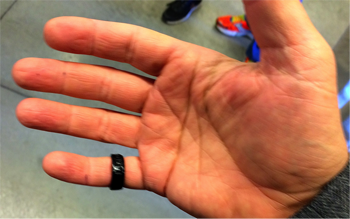Authors: Aaron Marcus
Posted: Wed, December 03, 2014 - 4:32:12
In May 2014, I was blessed with three invitations to be a guest critic at three end-of-the-semester design courses in three different departments of two educational institutions. Here is a quick summary of my experience, much delayed because of professional course/workshop/lecture presentations and book writing.
New Product Development Course, Mechanical Engineering and Haas School of Business, University of California at Berkeley, Berkeley, California
This course is led by Prof. Alice M. Agogino, Department of Mechanical Engineering. (The course description is here.)
From what I have seen over the past few years, the course provides an experience in preliminary project planning of complex and realistic mechanical engineering systems, but includes the possibility of projects that are, in effect, mobile user-experience design. Design concepts and techniques are introduced, and student's do innovative design/feasibility studies and present them at the end of the course. The primary reading material is the textbook Product Design and Development (Second Edition) written by Karl Ulrich and Steve Eppinger, a rather basic step-by-step discussion of the processes. The course objectives include innovation and achieving customer-driven products. The topics covered include personas and empathic design; translating the "voice of the customer"; concept generation, selection, development and testing; decision analysis; design for the environment; prototyping; an ethics case study; universal design and entrepreneurship; and intellectual property. Sounds pretty comprehensive doesn’t it! Well, I am sure the students do get a good introduction to the design/development process.
The reviews were held in Innovation Lab at the Haas School of Business. Some projects that seemed, to me, especially interesting to the HCI/UX/CHI/IXD communities were these:
Headphones: A product that improves existing headphones by increasing longevity for daily active users while enhancing durability and ergonomics
ResidentSynch, The Smart Home: A product to integrate, monitor and optimize the use of the various products in urban households
Samsung-Intel Next Digital 1 (IoT): A platform that connects all of our devices with objects around us
Samsung-Intel Next Digital 2 (Sensorial Experience): The integration of technology and sensorial experiences, enabling consumers the ability to interact with technology in a way that stimulates multiple human senses simultaneously
Smart Alarm Clock: Redesign the experience of waking up and starting your day.
One of the more intriguing projects, which I reviewed in detail, was the Samsung Loop project, with a Samsung staff member as a mentor/guide. When people actually meet (not virtually), controlled information can pass from one ring to another when in close contact, for example, when people meet and shake hands. The device was clever, minimal in form, and similar to other ongoing research for “finger-top” devices. Of course, there is the cultural challenge that not all people shake hands upon meeting.

Example of the Loop finger-device for exchanging
information between people who actually meet.
(Photo by Aaron Marcus)
Even if some projects were quite inventive, most of the projects had mediocre presentations of their end results, perhaps not surprising from a group of engineering and business students. One exception was the work of an outstanding student Elizabeth Lin, a computer-science major, whose graphic design and explanatory skills were at a professional level.
University of California at Berkeley, Department of Computer Science, Course in Mobile Interaction Design, Berkeley, California
Prof. Bjørn Hartmann invited me to be a critic in his course, in which he offers, together with Prof. Maneesh Agrawala, a semester’s activity in learning about mobile user-experience design, mobile user-interface design, and mobile interaction design. The projects were impressive, as presented in two-minute visual, verbal, and oral summaries. Two other critics and I were asked to judge them. The two other people were much younger user-experience/interaction design professionals: Henrietta Cramer and Moxie Wanderlust, both from the San Francisco Bay area (by the way, Moxie Wanderlust made up his name in graduate school....an interesting user-experience design project in itself!).
Amazing to me was the fact that, after judging 24 presentations in under an hour, we were all almost identical in our judgments as to the best overall project, the best visual design, and the most original. I was a little worried that we would differ greatly in our reviews. We didn’t!
Here in this class, students were able to code or script working prototypes within eight weeks. Alas, insufficient time had gone into user-experience research, usability studies, and visual design. Not a surprise from a center for computer science. The course and the projects are well documented online:
California College of Arts, Department of Graphic Design, San Francisco, California
The lead professors of the senior thesis presentations, Prof. Leslie Becker and Prof. Jennifer Morla, invited me to join the group of guest critics for 20 senior thesis projects of varying media and subject matter. One of the most interesting was that of Maya Wiester, whose project focused on 3D printing of food and a mobile app that would manage food ordering. New characteristics for one’s favorite cuisine might include not only ethnic/national genre (Italian, Chinese, Thai, Mexican, etc.) and sustainability/healthfulness (vegan, organic, low-salt, no-MSG, gluten-free, local, etc.) but new attributes such as shape (Platonic solids, free-form, etc.), color (warm, cool, multi-colored, etc.), and surface texture (smooth, rough, patterned, etc.).

Example of 3D-printed food by Maiya Wiester.
Many of the projects were quite interesting and often powerful formal explorations, but usually without business/production/implementation considerations (no business plans), little testing/evaluation, and little or no implementation of computer-software-related applications.
What was evident from visiting all three educational sites was that each had its special emphasis, but no one place succeeded in providing, at an undergraduate (or graduate) level, the sufficient depth needed to produce the user-experience design professionals so much needed now. It seems that on-the-job experience is what gives new graduates the necessary depth and breadth of educational experience and expertise.
Perhaps it has always been this way. Some educational institutions claim to provide it, that is, the “complete package.” I think most do not deliver the complete set of goods, but some are trying harder. Having visited or talked with faculty at 5-10 institutions in the last year or two in five or six different countries, I am prepared to say that at least the educational leadership is aware of the challenge.
Posted in: on Wed, December 03, 2014 - 4:32:12
Aaron Marcus
View All Aaron Marcus's Posts







Post Comment
@silvana22 (2025 06 21)
Specialized blogs began to flourish, catalogo price shoes offering a space to reflect on emerging trends such as responsive design and touch-centric apps.